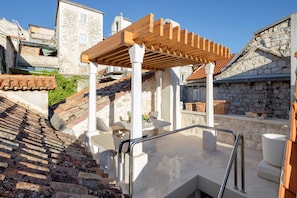Alarmed, they called upon the church’s canon and curator, Matija (Matthew) Lukanich. He was already shaken by the fact that the church’s roof went to pieces only minutes ago. When he found out about the blood he fell into a state of excruciating pain and near-madness.
As it happens, it was the very Lukanich who swore on that very crucifix in early 1509 to kill all of Hvar’s nobility. Lukanich was, along with Tomo (Thomas) Bevilaqua, the girl’s father and admiral’s son, the main conspirator of a planned coup and massacre that was to follow. Tomo Bevilaqua died in an accident in November of 1509, so the coup had to be postponed.
Now looking at the same crucifix bleeding made Lukanich fell into despair.
At first, all parties involved and the citizens of Hvar understood this as a warning from God, that saying to sustain from any bloodshed. As hours passed, Lukanich fell more and more into madness, ending up flagellating himself to death, six days after the discovery of the crucifix.
In the end, Hvar ended up in a civil war, which began in May 1510 and lasted for four years. Feel free to find out more by entering 'Hvar rebellion' into a search engine of your choice.
The events of 6th of February were first noted in detail by Hvar’s judge, Pavao (Paul) Paladinich. Other testimonies were collected by an apostolic visitor 69 years later, in 1579, from individuals who were children in time of these events. All testimonies were published in A. Gabelich’s ‘The uprising of Hvar’s commoners’ and J. Bracanovich’s ‘500 years of St. Cross worshipping’.
The bloodied crucifix and the adherent blooded cloth are kept today in the Hvar cathedral.
Be as it may, whether you believe in the story or not – you will be enjoying your vacation inside a living part of history, now there exclusively for your pleasure!









